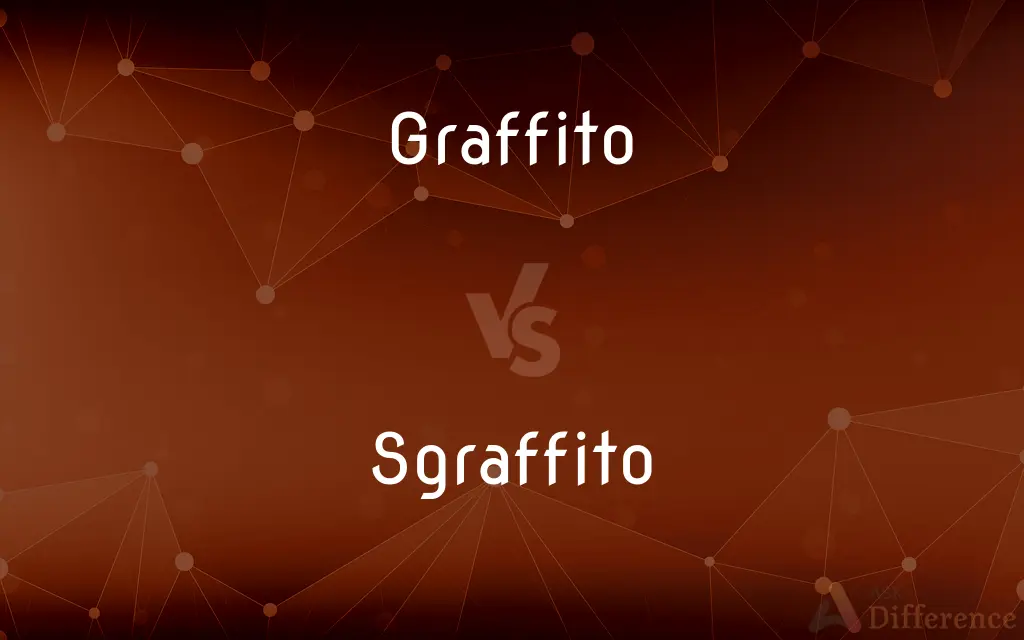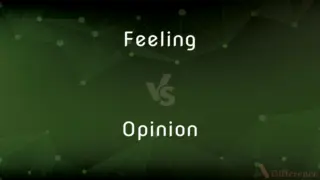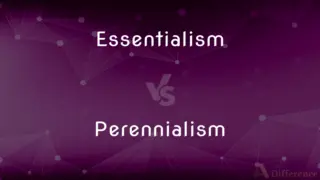Graffito vs. Sgraffito — What's the Difference?
By Maham Liaqat & Urooj Arif — Updated on April 8, 2024
Graffito refers to simple drawings or writings scribbled on a wall, while sgraffito is a pottery decoration technique, revealing a lower layer by scratching the surface.

Difference Between Graffito and Sgraffito
Table of Contents
ADVERTISEMENT
Key Differences
Graffito, often seen as informal or unsanctioned artwork, includes drawings, symbols, or words etched onto public surfaces, reflecting social or personal expressions. On the other hand, sgraffito is an artistic technique used primarily in pottery and ceramics, where the artist scratches away the top layer of material (such as plaster, clay, or glaze) to reveal a different color or texture underneath. This method creates intricate, contrasting designs.
While graffito can be found in urban environments across the world, acting as a form of self-expression or social commentary, sgraffito has historical roots in European and Middle Eastern art, serving as a decorative element in architecture and household items. Sgraffito involves a deliberate, artistic process, requiring tools and a specific skill set to achieve the desired effect.
Graffito's materials are often easily accessible, such as spray paint, markers, or even just a sharp object to etch into a surface. In contrast, sgraffito requires layers of plaster or glaze that can be manipulated before they fully set, along with specific tools designed for etching and carving.
The perception of graffito varies widely, with some viewing it as vandalism and others as a legitimate form of art and cultural expression. Sgraffito, however, is generally recognized and valued as an art form, often showcased in galleries and collections and taught as a technique in art schools.
Both graffito and sgraffito serve as means of communication through visual elements, but their intentions, techniques, and cultural receptions diverge significantly. Graffito often aims to challenge or engage public discourse, whereas sgraffito focuses on aesthetic beauty and the skill of the artisan.
ADVERTISEMENT
Comparison Chart
Definition
Art or writing scratched onto surfaces in public spaces
Artistic technique of scratching through layers to reveal underlying materials
Context
Urban environments, public spaces
Pottery, ceramics, and wall decorations
Materials Used
Spray paint, markers, sharp objects
Plaster, clay, glazes
Technique
Simple scratching or drawing
Detailed scratching to reveal a second layer
Cultural Perception
Varies from vandalism to art
Widely recognized as an art form
Compare with Definitions
Graffito
Symbolic or political expressions in public spaces.
The graffiti on the walls served as a form of protest against the government.
Sgraffito
A technique in pottery and ceramics for creating designs.
The potter adorned the vase with sgraffito, revealing a vibrant blue layer beneath the white.
Graffito
An act of defacing property with markings.
The graffito on the storefront was quickly removed by the owner.
Sgraffito
A method involving multiple layers of materials.
He applied two coats of glaze before executing the sgraffito technique.
Graffito
A simple drawing or piece of writing on a wall.
The alley was covered in graffiti, ranging from names to elaborate murals.
Sgraffito
Artistic decoration on buildings' exteriors.
The renaissance building was notable for its detailed sgraffito facades.
Graffito
Unauthorized scribbling or etching on public property.
Each graffito on the bridge tells a different story of the city.
Sgraffito
An intricate skill in the art world.
Her mastery of sgraffito brought her artwork to life, contrasting colors and textures beautifully.
Graffito
A mark left by ancient civilizations.
Archaeologists discovered a graffito on the ancient wall, possibly a message from the past.
Sgraffito
The process of scratching through a surface to reveal a lower layer.
The artist used sgraffito to bring depth to the mural.
Graffito
Singular of graffiti.
Sgraffito
Sgraffito (Italian: [zɡrafˈfiːto]; plural: sgraffiti) is a technique either of wall decor, produced by applying layers of plaster tinted in contrasting colours to a moistened surface, or in pottery, by applying to an unfired ceramic body two successive layers of contrasting slip or glaze, and then in either case scratching so as to reveal parts of the underlying layer. The Italian past participle "sgraffiato" is also used, especially of pottery.
Graffito
An informal inscription, as by a worker or vandal.
Sgraffito
Decoration produced (on pottery or ceramic, for example) by scratching through a surface layer to reveal a different color underneath.
Graffito
(rare) A single instance of graffiti in the art/vandalism sense.
Sgraffito
Something, such as pottery, decorated in this manner.
Graffito
Production of decorative designs by scratching them through a surface of layer plaster, glazing, etc., revealing a different-colored ground; also, pottery or ware so decorated; - chiefly used attributively.
Sgraffito
A technique in ceramics, art and wall design, where the top layer of pigment or slip is scratched through to reveal an underlying layer.
Graffito
The singular form of graffiti, seldom used.
Sgraffito
An instance or sample of sgraffito.
Graffito
A rude decoration inscribed on rocks or walls
Sgraffito
(art) To produce a design using this technique.
Sgraffito
Scratched; - said of decorative painting of a certain style, in which a white overland surface is cut or scratched through, so as to form the design from a dark ground underneath.
Sgraffito
A ceramic or mural decoration made by scratching off a surface layer to reveal the ground
Common Curiosities
What is graffito commonly made with?
Graffito is commonly made with spray paint, markers, or any sharp object to etch onto surfaces.
Where is sgraffito most often found?
Sgraffito is most often found in pottery, ceramics, and as decorative elements on buildings.
Can graffito be considered art?
Yes, graffito can be considered art, depending on the context and perception, ranging from vandalism to a respected form of cultural expression.
How do perceptions of graffito and sgraffito differ?
Perceptions of graffito vary widely from vandalism to art, while sgraffito is generally recognized and valued as an art form.
What is the purpose of graffito?
The purpose of graffito can range from simple vandalism to complex social and political commentary.
How is sgraffito used in modern art?
Sgraffito is used in modern art to create intricate designs in pottery and ceramics, as well as in architectural decorations.
How does the community typically respond to graffito?
Community response to graffito varies greatly, from appreciation of its artistic value to concerns over property damage.
What are the key materials for sgraffito?
The key materials for sgraffito include plaster, clay, and glazes that can be manipulated to reveal underlying layers.
How do artists choose locations for graffito?
Artists choose locations for graffito based on visibility, significance to the message, and sometimes, the risk associated with the act.
Can sgraffito be done on surfaces other than pottery?
Yes, sgraffito can be done on various surfaces, including walls, using layers of plaster or similar materials.
Is sgraffito an ancient technique?
Yes, sgraffito is an ancient technique with historical roots in European and Middle Eastern art.
Can anyone create a graffito?
Technically, anyone can create a graffito, but its legality and social acceptance vary.
Does sgraffito require special tools?
Yes, sgraffito requires specific tools designed for etching and carving through layers of material.
Is sgraffito taught in art schools?
Yes, sgraffito is often taught as a technique in art schools, highlighting its recognition as a legitimate art form.
What skills are needed for sgraffito?
Sgraffito requires artistic skill, including the ability to plan and execute detailed designs through scratching techniques.
Share Your Discovery

Previous Comparison
Feeling vs. Opinion
Next Comparison
Essentialism vs. PerennialismAuthor Spotlight
Written by
Maham LiaqatCo-written by
Urooj ArifUrooj is a skilled content writer at Ask Difference, known for her exceptional ability to simplify complex topics into engaging and informative content. With a passion for research and a flair for clear, concise writing, she consistently delivers articles that resonate with our diverse audience.
















































